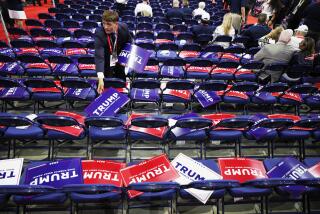Unions Hope to Avoid Debating U.S. Policy
In an unusual move, leaders of the AFL-CIO are sending out special “missions” across the country in an attempt to head off what could be the only acrimonious debate at the national AFL-CIO convention next month in Anaheim: differences over U.S. policies in Central America.
The convention will mark the 30th anniversary of the marriage of the conservative American Federation of Labor and the left-leaning Congress of Industrial Organizations.
Until the merger, and at times even afterward, America’s unions fought each other almost as furiously as they battled employers and their political foes, quarreling with one another over issues ranging from political ideology and endorsements to battles over jurisdiction.
But, weaker than they have been in decades--because of, among other factors, a gradual shift in the nature of the nation’s work force--unions today seem to feel that they cannot afford the luxury of inter-union struggles. In fact, organized labor today is acutely aware that its major foes are not within the movement but on the outside, from President Reagan to large corporations. And in many of those battles, the AFL-CIO is losing.
While union leaders still debate strategy and tactics on a variety of issues, they urgently seek consensus whenever possible. There are, nevertheless, some sharp differences among leaders of the federation these days over U.S. policies in Central America. And even those differences may be resolved before the convention begins as a result of meetings being held around the nation to discuss AFL-CIO foreign policy positions.
AFL-CIO staffers in the United States who deal with foreign policy questions have held meetings with union leaders in New York and Detroit and they will meet with others this weekend in Dallas to explain and “clarify” the sometimes confusing AFL-CIO policies on Nicaragua and El Salvador. A similar meeting will be held just before the convention in Anaheim.
One of the purposes of the meetings is to deal with the issues raised by the presidents of 20 of the largest AFL-CIO international unions (along with the leaders of such independent unions as the giant National Education Assn.) who have joined the National Labor Commmittee on El Salvador. The loosely knit commmittee has now enlarged its fact-finding activities to include Nicaragua.
So far, that committee has no formal resolutions to present to the AFL-CIO convention, but most of the individual unions and the Oregon AFL-CIO have already offered resolutions aimed at getting official AFL-CIO convention backing for their positions:
- Opposition to aid of any kind from the United States to the U.S.-backed contras , who are seeking to overthrow the Sandinista government in Nicaragua.
- More restrictions on U.S. aid to the government of El Salvador until there is more progress toward human rights, a complete end to right-wing “death squad” operations, more action on land reform and an overhaul of the judicial system.
AFL-CIO President Lane Kirkland has said that he opposes aid to the Nicaraguan contras , but the official federation policy is unclear. By way of illustration, at the unusual union missions on foreign policy, William C. Doherty Jr., executive director of the AFL-CIO’S American Institute for Free Labor Development (AIFLD), has differed with Irving Brown, AFL-CIO foreign policy director, on just what stand the AFL-CIO is taking on Nicaragua.
And, although the AFL-CIO convention two years ago called for an end to military aid to El Salvador until progress is made on such issues as human rights, union leaders are still debating whether enough progress has been made in El Salvador to justify AFL-CIO support for continued U.S. military aid to that country.
Thus, there could well be heated debate on those questions at this year’s convention unless compromise language can be found to please both the moderates in the AFL-CIO and the more impassioned anti-communists who often back President Reagan’s position of violence, if necessary, to fight communists (as they define them) in Central America and elsewhere.
The close ties between Doherty’s militantly anti-communist AIFLD and the U.S. government is evidenced by the fact that AIFLD gets almost all of its estimated $8-million annual budget from the U.S. government’s Agency for International Development. AIFLD has offices in 16 countries around the world.
Ironically, Doherty, who has been leading AIFLD for 23 years, is the son of William Doherty, who was president of the National Assn. of Letter Carriers for 21 years. Today, that union is among those seeking a more liberal policy for the AFL-CIO in Central America.
But even the most fervent anti-communists, such as AIFLD’s Doherty, are not likely to denounce their opponents as communists or communist sympathizers, something that might well have occured just a few years ago.
And the foreign policy debates, even if they do take place, will occupy only a portion of the convention time.
Delegates are expected to reach agreement far more easily on a variety of proposals that they hope will revitalize the labor movement. Among other things, they will consider plans to push the concept of “associate” union members.
For instance, when a union loses an election to represent workers in a plant of, say, 500 employees, 200 of them may have voted for the union. But under the system now used by almost all unions, majority rules and none of the 500 workers are affiliated in any way with the union after the election is lost.
The new plan would offer those 200 “associate memberships” so the union can maintain contact with those workers and so those workers can at least make use of the union’s mass purchasing power to get better prices for anything from insurance to travel bargains.
The convention will also be asked to approve a plan that will financially strengthen state-level AFL-CIO federations. At present, only about 55% of the members of the national AFL-CIO are affiliated with, and therefore pay dues to, the state AFL-CIO organizations. The new proposal calls for an increase in national-level dues, a portion of which will then be used to make all members of the national organization automatically members of the 50 state-level federations.
Back Pay for Drivers
The wheels of justice moved so slowly for former drivers of defunct Yellow Cab in Los Angeles that many of them still cannot be located to hear the good news: Their nearly 10-year-old claim for back wages of up to $1,000 each can now be collected.
State Labor Commissioner C. Robert Simpson said last week that the Department of Industrial Relations has finally received $558,000 in back wages to distribute to the former drivers. The total may be even higher once bankruptcy proceedings are finished.
Yellow Cab went out of business in 1976 and close to $500,000 was paid to the drivers in 1976 and 1977. Simpson said bankruptcy proceedings delayed payment of most of the remaining claims until now.
This is actually an ironic twist, considering the length of time involved before the drivers could get their money. According to Hugo Morris, spokesman for the Southern California Joint Council of Teamsters 42 here, before Yellow Cab’s financial collapse, the union and company had agreed that the company could use income from a fare increase to help pay off the massive debt to the workers’ pension and health and welfare funds. Normally, the drivers’ paychecks would increase as a result of the fare hike.
But the company-union agreement also provided that, if the firm did go into bankruptcy proceedings, most of the money received from the fare hike would then go to the drivers and not be used to first pay off other creditors. In other words, the drivers were willing to help subsidize the company so it could stay in business, not to ease the economic pains of bankruptcy.
The legal process took so long that at least some of those who made the financial sacrifice nearly a decade ago to help save both their jobs and the company may not get their money. Many of the 1,200 Yellow Cab workers here have been located, but those who have made claims and have not yet been contacted should write to Simpson at the Division of Labor Standards Enforcement, Rooom 606, 525 Golden Gate Ave., San Francisco, Calif., 94102.
Farmer John Strike?
Los Angeles-based Farmer John Meat Co. faces an Oct. 1 strike-boycott by nearly 1,000 members of the United Food and Commercial Workers unless negotiators can work out a new contract before the current agreement expires at midnight next Monday.
Union spokesman Dan Swinton said that, if the strike-boycott does come, the union will set up consumer-information picket lines at Dodger Stadium, where Farmer John Dodger Dogs are sold, and the union is asking officials at other public events such as football games and conventions where Farmer John products are sold to support the boycott.
Union members voted 433 to 29 last week to authorize a strike. Swinton said the key unresolved issues are medical-care costs and pension-plan provisions. The company wants to eliminate the two current programs, and, with reduced company contributions, create new funds that will be unilaterally controlled by the company, he said. Now the funds are jointly administered by company and union representatives.
The company has offered a bonus of 25 cents an hour to be paid at the end of each quarter of the proposed three-year pact, but the increase would not be permanent. The “bonus” concept is becoming more and more common as a device to hold wages down. When contracts come up for renewal, workers who accept such bonuses must then negotiate just to keep the bonus during the life of the new contract. A request for an additional pay raise has to be made separately.
Since it is obviously more difficult for union members to get what amounts to a double raise, unions have been fighting the bonus concept. But they often accept the bonus idea because the alternative may be a strike--or no pay increase at all. And, of course, there is no guarantee that a strike will succeed in getting a hike in the basic wage.
Union and company negotiators are scheduled to meet today with federal mediator Frank Allen in another attempt to reach a settlement.
More to Read
Inside the business of entertainment
The Wide Shot brings you news, analysis and insights on everything from streaming wars to production — and what it all means for the future.
You may occasionally receive promotional content from the Los Angeles Times.










